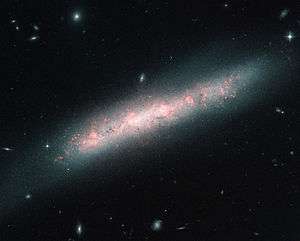NGC 4700
Coordinates: ![]() 12h 49m 08.148s, −11° 24′ 35.48″
12h 49m 08.148s, −11° 24′ 35.48″
| NGC 4700 | |
|---|---|
|
The galaxy NGC 4700 bears the signs of the vigorous birth of many new stars. | |
| Observation data (J2000 epoch) | |
| Constellation | Virgo[1] |
| Right ascension | 12h 49m 08.148s[2] |
| Declination | −11° 24′ 35.48″[2] |
| Redshift | 0.00480[2] |
| Helio radial velocity | 1435 km/s[2] |
| Distance | 50 million ly[1] |
| Characteristics | |
| Type | Barred spiral galaxy |
| Other designations | |
| LEDA 43330, SINGG HIPASS J1249-11, [NLB95] f717g006, 6dFGS gJ124908.2-112436, 2MASX J12490814-1124354, [CHM2007] HDC 740 J124908.14-1124354, [VV2000c] J124907.1-112444, HIPASS J1249-11 MCG-02-33-013, [CHM2007] LDC 904 J124908.14-1124354, [VV2003c] J124907.1-112444, IRAS 12465-1108, 2MFGC 10101, [DML87] 662, [VV2006c] J124907.1-112444, IRAS F12465-1108, PSCz Q12465-1108, [HB91] 1246-111, [VV98c] J124907.1-112444 | |
NGC 4700 is a spiral galaxy located 50 million light years away in the constellation of Virgo. NGC 4700 was discovered in March 1786 by the British astronomer William Herschel who noted it as a "very faint nebula".
References
- 1 2 "A Galaxy Festooned with Stellar Nurseries". ESA/Hubble Picture of the Week. Retrieved 23 July 2012.
- 1 2 3 4 "Search results for NGC 4700". Astronomical database. SIMBAD. Retrieved 23 July 2012.
| Wikimedia Commons has media related to NGC 4700. |
This article is issued from Wikipedia - version of the 7/19/2015. The text is available under the Creative Commons Attribution/Share Alike but additional terms may apply for the media files.
